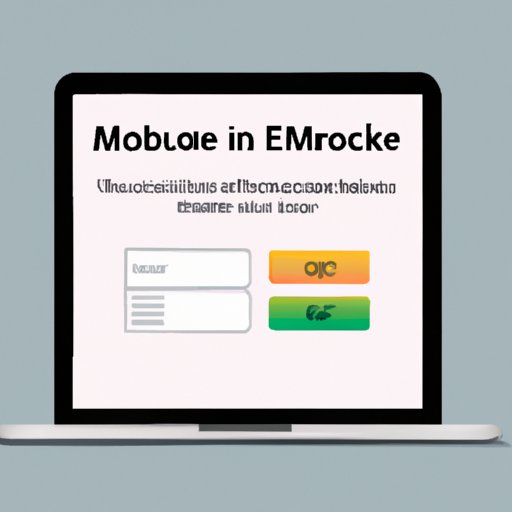
Introduction
Dealing with a virus infection on your MacBook Pro can be a frustrating and stressful experience. Viruses can significantly slow down or even damage your device, and sometimes, they can compromise your personal information. It is crucial to remove viruses as soon as possible to prevent further problems. Luckily, there are several ways to remove viruses from your MacBook Pro.
Option 1: Install Anti-Virus Software
It is highly recommended to have anti-virus software installed on your MacBook Pro to protect it from viruses and malware. Anti-virus software can detect and remove threats before they damage your device. Follow these steps to install anti-virus software on your MacBook Pro:
- Research and choose reputable anti-virus software.
- Visit the company’s website and download the software.
- Double-click the downloaded file to start the installation process.
- Follow the instructions on the screen to complete the installation process.
- Run a full system scan to detect and remove viruses.
Examples of reputable anti-virus software for MacBook Pro include Avast, Norton, and McAfee.
Option 2: Remove Unnecessary Programs and Files
Unnecessary programs and files can clutter your MacBook Pro, taking up valuable space and slowing down its performance. In some cases, these programs and files can also cause virus infections. Follow these steps to remove unnecessary programs and files from your MacBook Pro:
- Identify unnecessary programs and files.
- Click on the program or file and drag it to the Trash bin.
- Empty the Trash bin to permanently delete the program or file.
Tips for identifying unnecessary programs and files include checking your Downloads folder, deleting old applications, and getting rid of large files and duplicates.
Option 3: Boot in Safe Mode
Boot your MacBook Pro in Safe Mode to diagnose and remove virus infections. Safe Mode boots your device with only the essential software and drivers needed to run it, making it easier to isolate and remove viruses. Follow these steps to boot your MacBook Pro in Safe Mode:
- Restart your MacBook Pro.
- Press and hold the Shift key immediately after hearing the startup sound.
- Release the Shift key when the Apple logo appears.
- Log in to your account.
- Run a full system scan to find and remove viruses.
The advantages of using Safe Mode to remove viruses include the ability to isolate viruses and diagnose the root of the problem. However, using Safe Mode can limit your device’s functionality and may not always resolve the issue.
Option 4: Clear Cache and Delete Suspicious Email Attachments
Clearing your cache and deleting suspicious email attachments can prevent viruses from infecting your MacBook Pro. Caches and email attachments can harbor viruses, making it essential to clear them regularly. Follow these steps to clear cache and delete suspicious email attachments:
- Open Safari.
- From the menu bar, select Safari > Clear History and Website Data.
- Choose the time range you want to clear, and click on Clear History.
- Open your email client and select the suspicious email attachment.
- Press Control-click (or right-click) on the attachment and select Move to Trash.
Best practices for email management include not opening suspicious emails or attachments, configuring spam filters, and avoiding clicking on links in emails from unknown sources.
Option 5: Restore MacBook Pro to Factory Settings
In some cases, restoring your MacBook Pro to its factory settings may be necessary to remove viruses. This should be a last resort option, as it will erase all data and reinstall the original operating system. Follow these steps to restore your MacBook Pro to its factory settings:
- Back up all important data to an external hard drive or cloud storage.
- Restart your MacBook Pro and hold down the Command and R keys until the Apple logo appears.
- Select Disk Utility and click Continue.
- Select your startup disk and click Erase.
- Follow the instructions on the screen to reinstall your operating system.
The advantages of using this option include the ability to completely remove viruses and start fresh with a clean operating system. However, it will erase all data, so a backup is essential.
Option 6: Contact Customer Support
If none of the above options work, contacting customer support may be necessary. Apple customer support can provide additional tips and information to help you remove viruses from your MacBook Pro. To contact customer support, follow these steps:
- Visit the Apple Support website.
- Select your device and the issue you are experiencing.
- Choose the contact method that works best for you.
The advantages of seeking professional help include the ability to get personalized support and guidance from trained professionals.
Option 7: Practice Safe Browsing Habits
Practicing safe browsing habits can prevent future virus infections on your MacBook Pro. Follow these best practices to ensure safe browsing:
- Install an ad-blocker to prevent pop-ups and malicious advertisements.
- Only visit trusted websites and avoid clicking on suspicious links.
- Avoid downloading files or software from unknown sources.
- Keep your software and operating system up to date with the latest security patches.
Conclusion
Removing viruses from your MacBook Pro can seem like a daunting task, but there are several options available to help you achieve this. Whether you choose to install anti-virus software, remove unnecessary programs and files, boot in Safe Mode, clear cache and delete suspicious email attachments, restore your MacBook Pro to factory settings, seek customer support, or practice safe browsing habits, the key is to take action as soon as possible to prevent further damage. Remember to choose the option that works best for your personal needs and circumstances and practice safe browsing habits to prevent future virus infections.




